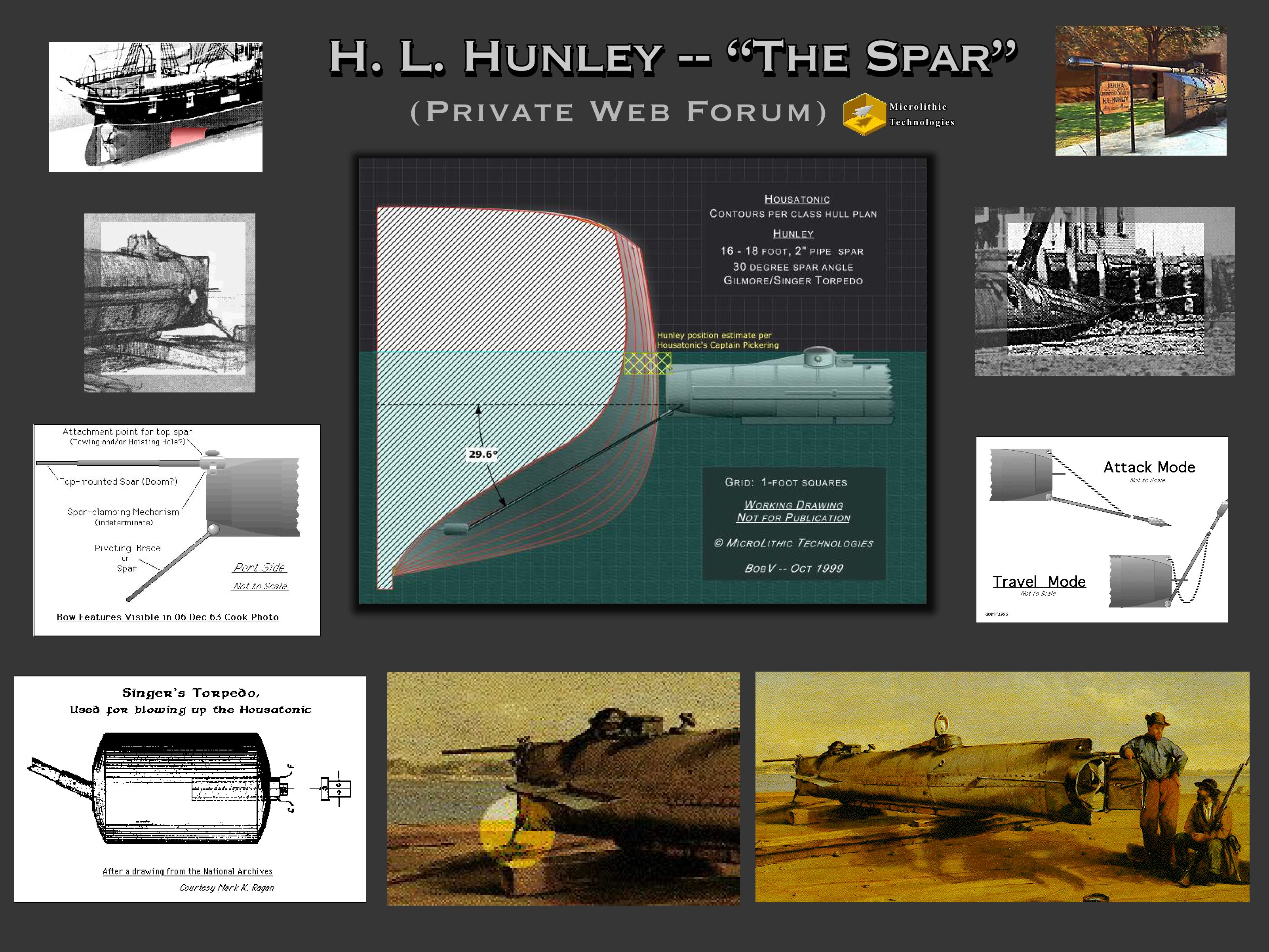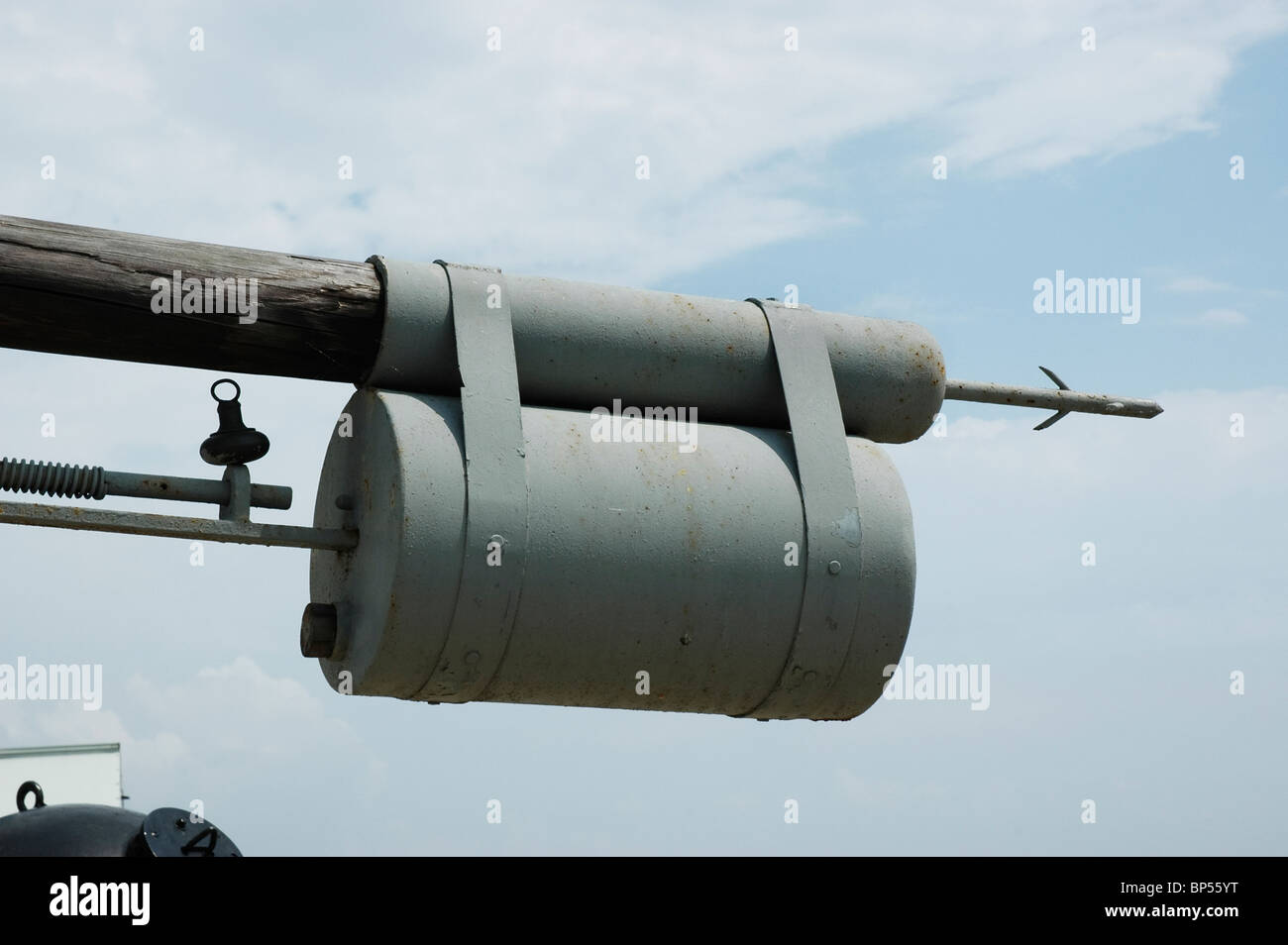Skip to comments.
How eight crew members on board the Confederate H.L. Hunley submarine were killed by their OWN torpedo after they sunk a Union warship in 1864
Daily Mail ^
| February 19, 2020
| Keith Griffith
Posted on 02/19/2020 6:23:52 PM PST by rockrr
The scientist who cracked the 150-year-old mystery of the the sinking of the H.L. Hunley Confederate submarine has revealed the painstaking steps she took to demonstrate what killed its eight-man crew.
Rachel Lance, a biomedical engineer and blast-injury specialist, describes her breakthrough in the forthcoming book In the Waves: My Quest to Solve The Mystery of A Civil War Submarine, due out April 7.
The Hunley was the first combat submarine to sink an enemy warship, but as soon as it succeeded in its mission targeting the USS Housatonic in Charleston harbor in 1864, it mysteriously sank with all hands lost.
The sub was raised from the ocean floor in 2000, adding to the mystery when it became clear that there was no damage to the hull itself.
While many theories have been put forward, Lance believes that the crew was killed nearly instantly by the pressure wave from their own torpedo.
(Excerpt) Read more at dailymail.co.uk ...
TOPICS: History
KEYWORDS: civilwar; csa; godsgravesglyphs; hunley; navy
Navigation: use the links below to view more comments.
first previous 1-20, 21-40, 41-60, 61-71 next last
To: rockrr
I’ve always been fascinated by the bravery of those who went down on the Hunley. It’s kind of comforting to know they didn’t suffer.
21
posted on
02/19/2020 7:27:52 PM PST
by
Reddy
( B.O. stinks)
To: taxcontrol
Takes a special kind of courage to crawl into a little metal tube that sank twice before.It sure does!
To: rockrr
Thanks for posting. Have had a life-long interest in the H.L. Hunley since watching the premier episode ("The Hunley") of CBS's "The Great Adventure" on 9/27/1963. Finally made the trip to North Charleston in 2007 to view the Hunley at the Warren Lasch Conservation Center.
Loved the pictures. It is fascinating that to see the best pictures of events in the U.S., be they political, criminal, etc., I end up at British web-sites, e.g., UK Daily Mail.
To: rockrr
To: rockrr
A remarkable piece of southern engineering.
To: DiogenesLamp
It wasn’t me, but I do know something on the subject. The torpedo had a barbed spike on the forward end. This lodged in the Housatonic’s hull and the Hunley went full astern. The charge pulled loose from the spar, and a line ran from the charge to a spool on the upper side, starboard I believe, just forward of the hatch. When the line pulled tight, the charge was detonated. This would give a slight stand-off when the charge went off. However, in an uncompressible environment, it really wouldn’t have made much of a difference.
26
posted on
02/19/2020 7:58:25 PM PST
by
75thOVI
(Any sufficiently advanced stupidity is indistinguishable from malice.)
To: rockrr
“You arrogant ass. You’ve killed US!”
27
posted on
02/19/2020 8:00:09 PM PST
by
grey_whiskers
(The opinions are solely those of the author and are subject to change with out notice.)
To: usconservative
"...2000, adding to the mystery"
What's that?
Mystery Submarine Theater 2000?
28
posted on
02/19/2020 8:00:41 PM PST
by
grey_whiskers
(The opinions are solely those of the author and are subject to change with out notice.)
To: 75thOVI
Another threory, given he bodies were found at their stations and not piled up at the hatch was asphyxiation. They had to wait for the tide to shift as they did not have the energy to row home and they just slowly ran out of oxygen and passed out. we visited her and the cemetery a few years back.
29
posted on
02/19/2020 8:20:46 PM PST
by
bravo whiskey
(Never bring a liberal gun law to a gun fight.)
To: Repeal The 17th
Hey, it coulda happened. If they had the BP in a steel can and tied it to the bumper. :)
30
posted on
02/19/2020 8:28:56 PM PST
by
TigersEye
(MAGA - 16 more years! - KAG)
To: bravo whiskey
Actually the problem would not have been lack of O2, but rather CO2 build up. I visited the cemetery a few years back myself. Left my dolphins on Lt. Dixon’s grave.
31
posted on
02/19/2020 8:31:13 PM PST
by
75thOVI
(Any sufficiently advanced stupidity is indistinguishable from malice.)
To: 75thOVI
It wasn’t me, but I do know something on the subject. The torpedo had a barbed spike on the forward end. This lodged in the Housatonic’s hull and the Hunley went full astern. The charge pulled loose from the spar, and a line ran from the charge to a spool on the upper side, starboard I believe, just forward of the hatch. When the line pulled tight, the charge was detonated. This would give a slight stand-off when the charge went off. However, in an uncompressible environment, it really wouldn’t have made much of a difference. This is actually incorrect. This was the method they thought was used, but the Freeper that posted the pictures last year had proof that the torpedo was permanently attached to the iron spar. The remains of the copper container can still be seen firmly bolted to the iron spar. It didn't come off.
32
posted on
02/19/2020 10:18:27 PM PST
by
DiogenesLamp
("of parents owing allegiance to no oither sovereignty."/)
To: Whenifhow; null and void; aragorn; EnigmaticAnomaly; kalee; Kale; AZ .44 MAG; Baynative; bgill; ...
33
posted on
02/19/2020 10:20:23 PM PST
by
bitt
(We, the people, are who they fear will one day awake.)
To: rlmorel; rockrr
" Didn’t you have some involvement in this?"
~~~~~~~~~~~~~
Indeed I did.
Before the Hunley was raised, I created and hosted an online forum which included archæologists, engineers & historians on the Hunley team. It was we who first determined that the torpedo was deployed on a 18 foot metal pipe from the bottom of the bow, pivoted vertically on a y-shaped yoke, and deployed at a downward angle of thirty (30) degrees for attack.

Summary "Slide" from the Forum...
In fact, our recommendations contributed to the "spar"'s being removed and raised before the Hunley was.
When I visited the Hunley in the Lasch Lab in Charleston in 2013, I learned that the torpedo had been bolted solidly to the spar -- so that the Hunley was only 16-18 feet from the explosion of the torpedo's 130 lbs of cannon powder.
Since then, I've determined analytically that it was Singer's torpedo design that was used, and I recently identified how the Singer "Lanyard-triggered" fuzes were readily converted to Contact-triggered function. (Bolting the torpedo to the spar necessitated Contact-triggered fuzing...)
Thanks for the ping! (I'm in general agreement with Rachel Lance, but my analysis includes physiological factors that she, apparently, didn't consider...)
Thanks for the ping!!!
TXnMA

34
posted on
02/19/2020 10:23:14 PM PST
by
TXnMA
("Allah": Satan's alias | "Islam": Allah's useful idiots | Brennan & 0b0z0: Islam's useful idiots)
To: DiogenesLamp
Thank you very much sir! I’ve always said that the day I couldn’t learn something new was the day you could plant me.
35
posted on
02/19/2020 10:30:41 PM PST
by
75thOVI
(Any sufficiently advanced stupidity is indistinguishable from malice.)
To: DiogenesLamp; 75thOVI; MacNaughton
"...the Freeper that posted the pictures last year had proof that the torpedo was permanently attached to the iron spar." ~~~~~~~~~
I expect that I was "the FReeper who posted the pictures" to which you referred...
See my #34, on this thread...
TXnMA

36
posted on
02/19/2020 11:03:17 PM PST
by
TXnMA
("Allah": Satan's alias | "Islam": Allah's useful idiots | Brennan & 0b0z0: Islam's useful idiots)
To: TXnMA; All
135 pounds of cannon powder -- not "130"...
TXnMA

37
posted on
02/19/2020 11:09:17 PM PST
by
TXnMA
("Allah": Satan's alias | "Islam": Allah's useful idiots | Brennan & 0b0z0: Islam's useful idiots)
To: TXnMA
Thanks for posting that image. I never thought to look at the
bottom of the bow in that famous 1864 painting. Old ideas, even the false ones still hang on.
Example #1 - H.L. Hunley replica on the exterior grounds of the Charleston (SC) Museum.

Example #2 - H.L. Hunley replica at Battleship Park, Mobile, AL


To: SunkenCiv
39
posted on
02/20/2020 2:56:13 AM PST
by
fieldmarshaldj
(Dear Mr. Kotter, #Epsteindidntkillhimself - Signed, Epstein's Mother)
To: TXnMA
That is fascinating work, TXnMA. I envy you-the REAL contact with history is something that I occasionally only get touches of, and you were immersed in it.
LOL, two unintended references to “contact” and “immersion” there...:)
40
posted on
02/20/2020 3:51:54 AM PST
by
rlmorel
(Finding middle ground with tyranny or evil makes you either a tyrant or evil. Often both.)
Navigation: use the links below to view more comments.
first previous 1-20, 21-40, 41-60, 61-71 next last
Disclaimer:
Opinions posted on Free Republic are those of the individual
posters and do not necessarily represent the opinion of Free Republic or its
management. All materials posted herein are protected by copyright law and the
exemption for fair use of copyrighted works.
FreeRepublic.com is powered by software copyright 2000-2008 John Robinson




